

Article Detail. Comparisonreviewtestprep. Free Fiction & Nonfiction Literacy Resources, Curriculum, & Assessment Materials for Middle & High School English Language Arts. Actively Learn. Teaching Resources. Skip navigation and jump directly to page content Indiana University BloomingtonIndiana University BloomingtonIU Bloomington Search Center for InnovativeTeaching and Learning Home / Resources / Teaching Resources Teaching Resources The resources listed here can provide you with some quick ideas on key teaching topics or starting points to explore various aspects of teaching.
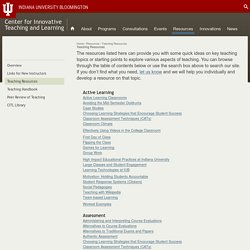
Fulfilling the Promise Privacy Notice Copyright © 2015 The Trustees of Indiana University,Copyright Complaints. Professional Journals and Magazines - Essentials for Teacher Librarians - LibGuides at CiSSL. Digital Edition Teacher Librarian, or TL as we’re often called, is designed specifically for you, the library professional working with children and young adults.
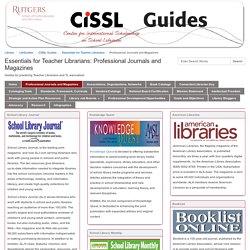
Within our pages you’ll find lively and relevant articles exploring current issues such as collaboration, leadership, technology, advocacy, information literacy, and management. Regular sections include: * Reviews of education and library-related professional materials * Strategies to help you better manage library resources * Articles to keep you up-to-date on the latest in information technology. Teaching with the Library of Congress. Stop-action photography has become an integral part of our lives.
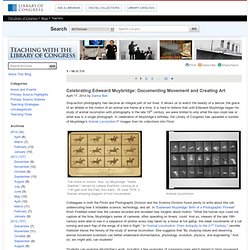
It allows us to watch the beauty of a dancer, the grace of an athlete or the motion of an animal one frame at a time. It is hard to believe that until Edweard Muybridge began his study of animal locomotion with photography in the late 19th century, we were limited to only what the eye could see or what was in a single photograph. In celebration of Muybridge’s birthday, the Library of Congress has uploaded a number of Muybridge’s Animal Locomotion images from its collections into Flickr. The horse in motion, illus. by Muybridge. “Sallie Gardner,” owned by Leland Stanford, running at a 1:40 gait over the Palo Alto track, 19 June 1878: 2 frames showing diagram of foot movements Animal Locomotion. Instructables - DIY How To Make Instructions. Best Websites for Teaching & Learning 2013.
Inside Search. North Carolina Digital Collections. Top Websites 2012. LEARN NC. North Carolina History: A Digital Textbook - LEARN NC. Primary sources, multimedia, readings, and lesson plans to tell the many stories of North Carolina's past.
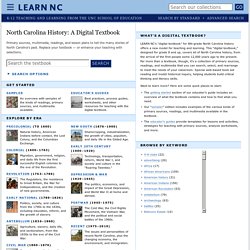
Replace your textbook — or enhance your teaching with selections. Get started Sampler An overview with samples of the kinds of readings, primary sources, and multimedia available. Educator’s Guides Best practices, process guides, worksheets, and other resources for teaching with the digital textbook. Explore by era Precolonial (to 1600) Natural history, American Indians before contact, the Lost Colony, and the Columbian Exchange. Colonial (1600–1763) Migration, government, religion, and daily life from the first successful English colonies to the eve of the Revolution. Revolution (1763–1789) The Regulators, the resistance to Great Britain, the War for Independence, and the creation of new governments.
Early National (1789–1836) Documents. Ites - Crowdsourcing Your PD. Beginner's Guide to Research. STEM Resources. Welcome to the STEM page, sponsored by YALSA's STEM Task Force. We hope you will use this wiki page to get ideas on how to effectively integrate STEM into your library programs and services. And what is STEM you ask? STEM stands for Science, Technology, Engineering, and Math and is one of the hottest topics in education and library circles. STEM programming is one way to engage teens in your library and encourage learning and exploration in new ways. We think this page is a good start on STEM resources, but we need your help to make it great. BUILDING GREAT STEM LIBRARY COLLECTIONS[edit] Carnegie Library of Pittsburgh: An extensive collection of STEM subject and career educational resources.
The National Science Teachers Association: Annual best books lists, Outstanding Science Trade Books for Students K–12, going back to 1996. YALSA’s blog, The Hub: A recent post on SciFi for Everyone. Locus Magazine: Recommended Reading List 2011. VOYA: Nonfiction Honor List. YOUNG ADULT NON-FICTION[edit] Planes Overhead and Other Cool Wolfram Alpha Things. LEARNING - Kinesthetic on Pinterest. Teacher Toolkit. Loaded: 0% Progress: 0% By the end of this tutorial, you’ll be familiar with the major features of Gooru.
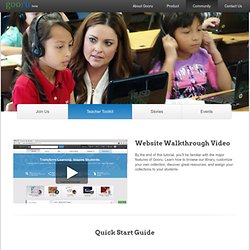
Learn how to browse our library, customize your own collection, discover great resources, and assign your collections to your students. Gooru in 3 Minutes Find multimedia learning materials for your classroom. Assign a Collection Browse the library for collections. Gooru in 10 Minutes Once you’ve found a collection you like, copy and customize it to fit your class. Customize a Collection Click “Customize” to edit the collection. Gooru in 15 Minutes Start from scratch! Create a Collection Use the search bar to find digital resources for your class. Access Prior Knowledge Help your students make connections between new material and their prior knowledge and experiences. Introduce New Material Introduce new information and skills to your students in an engaging way for meaningful learning right from the start. Quiz. Featured Courses.
Information Literacy Competency Standards for Higher Education. The Information Literacy Competency Standards for Higher Education (originally approved in 2000) were rescinded by the ACRL Board of Directors on June 25, 2016, at the 2016 ALA Annual Conference in Orlando, Florida, which means they are no longer in force.
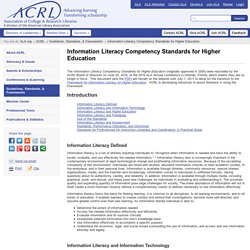
This document (and the PDF) will remain on the website until July 1, 2017 to allow for the transition to the Framework for Information Literacy for Higher Education. ACRL is developing resources to assist librarians in using the Framework. Introduction.